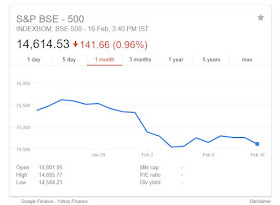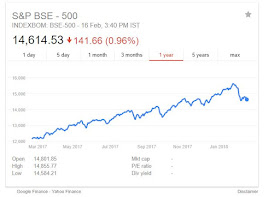Author : Vivek Kaul
The Dow Jones Industrial Average, America's premier stock market index, has fallen by close to 9%, over the last one week (i.e. between February 1 and February 8, 2018).
Closer to home, the BSE Sensex has fallen by 4.2% during the same period. As I write this on the morning of February 9, 2018, the BSE Sensex is down 1.5%, from its yesterday's close.
I think it's time to revisit a few basic things about the era of Easy Money, which has driven stock markets up post September 2008.
In the aftermath of Lehman Brothers going bust (September 15, 2008), and other financial institutions almost collapsing, and having to be bailed by taxpayers in the US and Europe, the Federal Reserve and other Western central banks, decided to print money and pump it into the global financial system.
This printed money (or rather created digitally) in the American case was pumped into the financial system by buying American treasury bonds and mortgaged back securities.
Treasury bonds are essentially bonds issued by the US government to finance its fiscal deficit. Fiscal deficit is the difference between what a government earns and what it spends.
Mortgages backed securities are securitised financial securities derived from mortgages (i.e. home loans).
The Federal Reserve had never owned mortgaged backed securities up until 2008. It had no reason to own private financial securities in order to carry out its open market operations.
It first started buying them only in January 2009. It started buying them only when a lot of financial institutions were in trouble and needed some "real money" to ride out of it.
Before 2009, the size of the Federal Reserve balance sheet was around $800 billion. By the time it finished, printing money and buying treasury bonds and mortgaged backed securities, it had ballooned to more than $4.2 trillion (See Figure 1).
Figure 1.
The hope was that with money supply going up, interest rates would fall, companies and people would borrow and spend money. This would lead to a faster economic recovery. The idea, as always was, that America will spend its way out of trouble.
But that is not how it worked out.
The trouble is that those making economic policies think only about what the economic policy hopes to achieve and not the incentives that it creates. And whether a policy achieves what it set out to achieve depends on the incentives it ends up creating. The incentives that got created in this case, were clearly not what the policy had hoped to achieve.
Companies borrowed money not to expand, but to buyback shares and increase their earnings per share. This, along with the fact that all the money printing had unleashed an era of easy money, led to a rally in US stocks.
Consumers who had just about finished with one round of borrowing (to buy homes primarily), weren't really in the mood to borrow all over again.
The big financial investors saw this as an opportunity to borrow money at cheap rates and invest it in stock markets all over the world. This trade came to be known as the dollar carry trade. A lot of money was made in the process.
It is worth pointing out here that the Federal Reserve, started buying American Treasury bonds big time, only from April 2009, onwards. Before this, it had started buying mortgaged backed securities from January 2009 onwards. The economists called this money printing, quantitative easing.
This money is still a part of the global financial system. This money cannot be taken out all at once, and any process to take this money out of the global financial system, has to be, at best, be a gradual one.
The Federal Reserve of the United States understands this, and has started taking out the money that it had put into the financial system, in the aftermath of the financial crisis. In fact, the Federal Reserve has gradually been sucking this money out of the financial system, since October 2017.
Between October and December 2017, the Federal Reserve, took baby steps, and withdrew a meagrely $10 billion per month. This has jumped up to $20 billion per month for the period January to March 2018. And this will gradually go up to $50 billion per month, starting October 2018.
In order to put the printed money into the financial system, the Federal Reserve bought treasury bonds and mortgaged backed securities. In order to pull money out, it is selling the bonds and the mortgage backed securities.
This year, it is supposed to sell $420 billion of these securities. The current size of the balance sheet of the Federal Reserve is around $4.2 trillion. By the end of the year, it would have shrunk by 10% to $3.8 million.
Next year and onwards, it is supposed to sell $600 billion.
As this money gets pulled out of the financial system, it is obvious that interest rates in the US, will start going up again. In fact, they already have with the yield on the 10-year treasury bond crossing 2.85%, over the last few days.
The yield on government bonds acts as a benchmark to interest that needs to be paid on different kinds of borrowing. (Lending to the American government is deemed to be the safest form of lending). With the bond yields going up, the interest that the institutional investors need to pay on their carry trade borrowings, will also go up.
With interest rates likely to go up, a lot of carry trades will unwind, simply because they will become unviable. As these carry trade unwinds, stock markets all over the world, are bound to fall.
Given that the Federal Reserve is pulling out the easy money it put into the global financial system, slowly, the markets should also fall slowly. While this seems like a logical argument to make, stock market and logic don't go together, at least in the short-term. The stock markets going up in many parts of the world wasn't really backed by an increase in company earnings. It was simply a result of all the easy money floating around.
What is important to understand here is that most investors essentially do what other investors around them are doing. If investors around them are buying, they will buy. If they are selling, they will sell. This herd mentality makes the stock market illogical, in the short-term.
Hence, the speed with which this fall will happen, might be very fast. But more than that the basic point is that the tide has turned, and the era of easy money is coming to an end.
In the context of the stock market, this means that any rubbish will not sell, as has been the case in the recent past. Investors will actually demand earnings from companies (yes, yes, there is a phrase like that) now and not just hope about it, as they have been all this while.
Another lesson here is that it might be difficult to predict the exact timing when the tide of the stock market, turns. But it is fairly easy to figure out whether the stock market is in expensive territory or not.
If you had read some of my earlier pieces, you would obviously know that by now. When these pieces were published, the sceptics said there was no reason for the stock market to fall right now. The trouble is, when markets are going up irrationally, there are never any reasons for them to fall (which is what makes them irrational in the first place), until one reason comes along. This is precisely how things always play out. And this time is no different.
SIPs remain the best way to invest in the stock market, given that most of us really do not have the time, the discipline and the inclination to figure out, what is the best for us, at least when it comes to investing. Also, I am not a big fan of buying on dips, because no one knows when the fall will end, and with this strategy one can end up buying stocks at fairly expensive valuations. So, SIPs remain the best way to buy stocks, in the long-term of 10 years or more.
Of course, the talking heads will keep talking about how the India growth story is still very strong, as they have constantly since 2002. It's your choice whether you listen to that rubbish in the media or make informed educated decisions about your hard-earned money.













